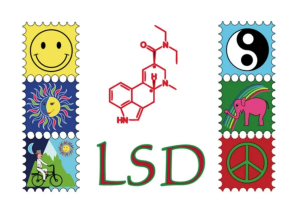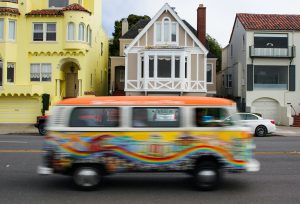9 LSD Throughout Time
Katie Lucas
Overview
Lysergic acid diethylamide, more commonly known as LSD, was initially created by a Swiss chemist, Albert Hoffmann, in 1938 (Hwang & Saadabadi, 2022). Hoffmann created and studied twenty-four different lysergic acid derivatives before synthesizing lysergic acid diethylamide. LSD’s intended purpose was to be used as a stimulant. After Hoffmann accidentally ingested the drug during one of his early studies, he discovered that LSD possessed hallucinogenic properties (Ulrich & Patten, 1991). Like many hallucinogens, LSD binds to serotonin receptors in the brain which can impact cognition and cause hallucinations (Hwang & Saadabadi, 2022). This drug is consumed by placing it under the tongue or swallowing, but it can also be sniffed, injected, or smoked. LSD effects are typically felt about 30 minutes after consumption and last 8-12 hours. People who consume LSD can experience euphoria, irregular or fast heart rate, and visual and auditory hallucinations (Alcohol and Drug Foundation, 2023). LSD has been around for nearly a century, yet researchers and healthcare providers are just scratching the surface of this drug’s science and possible applications.

Early Studies
Following the creation of LSD in 1938, there were no profound benefits and no further investigation was done on LSD for five years (Ulrich & Patten, 1991). The first European clinical study was published in 1947. In 1949, it was sent to researchers in the United States for psychiatric experiments. The first two medical researchers in the U.S. to test this drug were psychiatrists Max Rinkel in Massachusetts and Nick Bercel in California (Belouin & Henningfield, 2018). At this time, LSD was not FDA-approved nor documented via a New Drug Application (NDA). Insufficient regulation allowed psychiatrists to use LSD without any oversight. The lack of ethical research approaches caused studies to lack integrity and accuracy. Researchers acted as if LSD was a marketed drug with established safety which questioned the validity of the studies. These early studies defined LSD as a treatment for schizophrenia and an antidepressant (Bonson, 2018). Studies in the fifties and early sixties yielded promising evidence for LSD as an effective treatment for mental health disorders. However, social and political factors hindered the potential for further research (Oram, 2016).
Hippie Culture
During the 1960s, a social movement in the San Francisco Bay Area began (Wesson, 2011). 1967 was coined as the “Summer of Love” when over 75,000 youth who valued peace, love, and freedom of expression flooded the Haight-Ashbury District of San Francisco (Guida, 2021). This group protested the Vietnam War and the commercialism of America’s mainstream society (The Editors of Encyclopaedia Britannica, 2017). Blending eastern mysticism, Native American rituals, and psychedelic drug use, this movement became known as the “hippie movement” or “psychedelic drug counterculture.” LSD was explored during this movement for several reasons. Individuals used LSD recreationally to self-explore and experiment with transcendent experiences (Wesson, 2011). Timothy Leary and Richard Alpert were two highly influential individuals who studied psychedelics throughout the fifties and sixties. The duo became counterculture icons (Wark & Galliher, 2009). Leary is well known for his speech “turn-on, tune-in and drop-out,” given at Golden Gate Park in 1967. This speech empowered individuals from all walks of life to embrace the culture of psychedelics and detach from conventional societal norms. This led to the recreational use of LSD becoming more popular than ever before (Wesson, 2011).

FDA Bans
The increased use of LSD in the late sixties concerned government officials. In 1965, Congress passed the Drug Abuse Control Amendment (DACA). DACA gave the FDA control to regulate depressants, stimulants, and hallucinogens. A subsect of this law created the Bureau of Drug Abuse Control. The bureau regulated hallucinogens by prohibiting the manufacturing, processing, and sale of them unless approved by the government for a specific purpose, such as research, wholesale distribution, or medical applications (Bonson, 2018). Shortly after DACA was passed, the drug manufacturer of LSD, Sandoz Pharmaceuticals, decided to withdraw its sponsorship for LSD research. In 1970, the Controlled Substances Act categorized LSD as a Schedule 1 drug (Oram, 2016). Status as a Schedule 1 drug indicates no currently accepted medical use and has a high potential for abuse (DEA, 2018). The strict regulations on LSD halted most research on psychedelics for the foreseeable future.
Psychedelic Studies Today
For research studies involving psychedelics to be conducted today, extensive reviews must be conducted before approval. To determine if a study can proceed, the FDA looks at subject safety and if the study will uncover valid scientific data that justifies the risk of participation (Bonson, 2018). Recently, there have been initiatives for modern research on LSD. The current literature on LSD contains small sample sizes and difficulties with the structure of studies, limiting the validity of study findings (Smith, 2021). Modern psychedelic research has focused on psychotherapy concerning anxiety, depression, and alcohol dependence. Studies show evidence of the beneficial effects of LSD on alcohol misuse. (Krebs & Johansen, 2012). Another application of LSD is palliative care. LSD is used as a psychological therapy to help people face death (Dyck, 2015). Stigmas still surround LSD and its use. Modern trials are trying to combat these stigmas and avoid the pitfalls that previous studies have fallen into (Butler et al., 2022).
Conclusion
LSD has been controversial in medical research since its discovery in 1938. Early studies utilizing LSD as possible schizophrenia and antidepressant treatments lacked appropriate regulation by the FDA. The exponential growth of recreational LSD use during the Hippie Movement in the 1960s began to concern governmental officials. This ultimately led to the FDA banning research on LSD for many years. The reintroduction of modern psychedelic research will allow for potential new applications of LSD in areas such as mental health and palliative care.
Review Questions
1. LSD side effects include _________.
a. Irregular or fast heartbeat
b. Visual and auditory hallucinations
c. Euphoria
d. All of the above
2. Timothy Leary is known for _________.
a. synthesizing LSD
b. “Turn-on, tune-in and drop-out” speech
c. limiting the recreational use of LSD
3. True or false: The Drug Abuse Control Act of 1965 gave the FDA control to regulate depressants, stimulants, and hallucinogens.
a. True
b. False
References
Belouin, & Henningfield, J. E. (2018). Psychedelics: Where we are now, why we got here, what we must do. Neuropharmacology, 142, 7–19. https://doi.org/10.1016/j.neuropharm.2018.02.018
Bonson, K. R. (2018). Regulation of human research with LSD in the United States (1949-1987). Psychopharmacology, 235(2), 591+. https://doi.org/10.1007/s00213-017-4777-4
Butler, Jelen, L., & Rucker, J. (2022). Expectancy in placebo-controlled trials of psychedelics: if so, so what? Psychopharmacology, 239(10), 3047–3055. https://doi.org/10.1007/s00213-022-06221-6
Dyck E. (2015). LSD: a new treatment emerging from the past. Canadian Medical Association Journal, 187(14), 1079–1080. . https://doi.org/10.1503/cmaj.141358
Guida, J. (2021, June 21). The summer of Love wasn’t all peace and hippies. JSTOR Daily. https://daily.jstor.org/the-summer-of-love-wasnt-all-peace-and-hippies/
Hwang, K. A. J., & Saadabadi, A. (2022, July 11). Lysergic acid diethylamide (LSD). National Library of Medicine. https://www.ncbi.nlm.nih.gov/books/NBK482407/
Krebs, T. S., & Johansen, P.-Ø. (2012). Lysergic acid diethylamide (LSD) for alcoholism: Meta-analysis of randomized controlled trials. Journal of Psychopharmacology, 26(7), 994–1002. https://doi.org/10.1177/0269881112439253
Alcohol and Drug Foundation. (2023, January 10). LSD. https://adf.org.au/drug-facts/lsd/
Oram, M. (2016, July 24). Prohibited or regulated? LSD psychotherapy and the United States Food and Drug Administration. History of Psychiatry 27(3), 290 – 306. https://doi.org/10.1177/0957154X16648822
Smith, W. R., & Appelbaum, P. S. (2021). Two Models of Legalization of Psychedelic Substances: Reasons for Concern. JAMA, 326(8), 697–698. https://doi.org/10.1001/jama.2021.12481
The Editors of Encyclopaedia Britannica. (2017, September 1). Haight-Ashbury. Encyclopædia Britannica. https://www.britannica.com/place/Haight-Ashbury
Ulrich, & Patten, B. M. (1991). The Rise, Decline, and Fall of LSD. Perspectives in Biology and Medicine, 34(4), 561–578. https://doi.org/10.1353/pbm.1991.0062
United States Drug Enforcement Administration. (2018, July 10). Drug scheduling. https://www.dea.gov/drug-information/drug-scheduling#:~:text=Schedule%20I%20drugs%2C%20substances%2C%20or,Schedule%20II
Wark, & Galliher, J. F. (2009). Timothy Leary, Richard Alpert (Ram Dass) and the changing definition of psilocybin. The International Journal of Drug Policy, 21(3), 234–239. https://doi.org/10.1016/j.drugpo.2009.08.004
Wesson, D. R. (2011). Psychedelic drugs, hippie counterculture, speed and phenobarbital treatment of sedative-hypnotic dependence: a journey to the Haight Ashbury in the Sixties. Journal of Psychoactive Drugs, 43(2), 153–164. https://doi.org/10.1080/02791072.2011.587708
a manmade chemical that acts as a powerful hallucinogen
an agent (such as a drug) that produces a temporary increase of the functional activity or efficiency of an organism or any of its parts
a drug that causes hallucinations
a chemical in that body that plays a key role in body functions such as mood, sleep, and sexual desire
the conscious mental process involved in gaining knowledge and understanding the world
experiencing something that is not real
a feeling or state of intense excitement and happiness
involve seeing things that aren't real, like objects, shapes, people, animals or lights.
the sensory perceptions of hearing noises without an external stimulus
very great or intense
the vehicle through which drug sponsors formally propose that the FDA approve a new pharmaceutical for sale and marketing in the U.S.
the use of honest and verifiable methods in proposing, performing, and evaluating research
how well the results among the study participants represent true findings among similar individuals outside the study
a serious mental condition of a type involving a breakdown in the relation between thought, emotion, and behavior, leading to faulty perception, inappropriate actions and feelings, withdrawal from reality and personal relationships into fantasy and delusion, and a sense of mental fragmentation.
used to alleviate depression
the belief that there is hidden meaning in life or that each human being can unite with God
a countercultural movement during the 1960s and 1970s that promoted concepts of love and tolerance
beyond or above the range of normal or merely physical human experience
an activity done for personal enjoyment
specialized medical care that focuses on providing relief from pain and other symptoms of a serious illness

